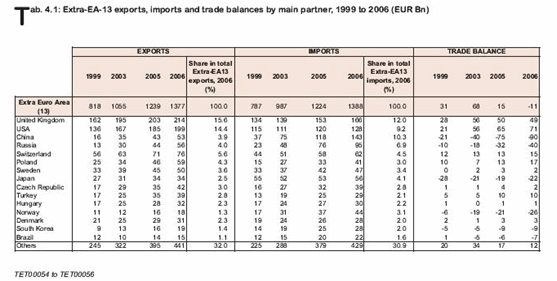Europe Faces Danger, While Commodities Ramping, Canada Could Benefit
Mark Whistler is the founder of www.WallStreetRockStar.com and is the author of multiple books on trading. Mark’s newest book, The Swing Trader’s Bible – co-authored with CNBC/Fox News regular guest Matt McCall – will be on shelves in late summer, 2008. In addition, Mark also writes regularly for TraderDaily.com and Investopedia.com.
Sign up for a free trial to Forex Force with Mark Whistler, a twice-daily alert service from professional trader Mark Whistler featuring intraday and swing trading setups. Click here to start your free trial.
1. Elevated Euro Troublesome for European Trade Balance
The News
On Friday, the Euro Zone Foreign Trader Report for March, showed a $3.6 billion deficit, versus February’s (roughly) $1.2 billion surplus.
The Breakdown
Europe’s overall trade balance has now shown negative numbers for three of the past four months of reported numbers. What’s more, when we look deep into Euro Area trade data, a few red flags immediately jump out at us. The table below is from the Euro Area’s Trade Data report with data from 1996 to 1999. What you will notice is that the Euro Area – in regard to trade balance – has been slowly slipping red over the past decade, at the same time that the euro has been gaining ground.Â

Source: European Commission: EuroStat
Notably, the Euro Area’s balance distinctly lost ground from 2003 to 2006, again, at the same time the euro was in a bold bull run – globally.
It’s important to remember that the U.S. only accounts for about 10% of Euro Area trade balance, however, there is a disturbing trend surfacing. Please also keep in mind that there are many items to construct trade balance as well, not just the U.S. Dollar. However, the below table shows that the Euro Area trade balance grows more and more red – consistently – as the euro gains ground. In fact, as the EUR/USD has begun to hold ground above the 1.4700 area, the overall Euro Area trade stays red, with the exception of February 2008, but the surplus was significantly small.

What’s more, the main trading partner for the Euro Area is Great Britain, which has been experiencing an economic slowdown of it’s own over the past few months, which is likely only hurting the trade balance even more.Â
The Bottom Line
The longer the euro stays at elevated levels – against most currencies globally – the Euro Area economy and trade balance continually add danger premium to GDP growth. And with the ECB’s reluctance to lower rates – due to inflation – the more hazardous the larger situation is becoming for Europe.Â
Â
2. Commodities Attempting Another Breakout
The News
Commodities – as noted in the CRB Index, are attempting another breakout higher.Â
The Breakdown
After hitting an all time high last week at $127.82 per barrel, oil continues to maintain a major driving force behind the present rally in commodities worldwide.
Much of the reason for the rally in commodities (and oil) have more to do with global government trade policy, over actual supply/demand issues. Oil, of course has its own woes with plenty of political tension and fear of global pipeline attacks; however, items like artificially propped corn prices for ethanol aren’t helping.Â
Case in point, the U.S. presently has a 54 cent per gallon tariff against Brazilian sugarcane ethanol and a 51 cent tax subsidy for corn producers. Get rid of the tariff and subsidy and corn prices (and other agricultural commodities) would fall via free flowing supply chains.Â
Regardless, even with Saudi Arabia’s commitment to increase production 300,000 barrels in June, prices aren’t showing too many signs of easing right now.  Â
Toss on the ECB’s refusal to take action to weaken the euro and the overall mix is a concoction for elevated oil prices overall.
The Bottom Line
In the present environment, elevated oil and commodity prices have more to do with the policies of OPEC and governments, over supply and demand, even with supply fears like that of “peak oil” now coming from Russia. The bulk of the “risk premium†in oil and commodities is coming from speculators, not true economics.
Â
3. Go North – Like to Canada Eh – At Least if Oil Keeps Rising
The News
With the recent rise in oil prices, several commodity-backed currencies like that of Australia and Canada attempt to gain ground.Â
The Breakdown
Last week, both the Australian and Canadian Dollars attempted to find strength in their relative ranges.Â
The problem; however, is that if the U.S. Dollar is able to find some sense of rebound in the coming weeks, the event could cause the AUD/USD to dip and the USD/CAD to rally. What’s more, as we’re already seeing in Canada, the country’s currency appreciation overall is starting to take a slight bit of a toll on the economy via declining exports to the U.S.
First quarter GDP in Canada is expected to come in around 1%, a far cry from 2.9% witnessed a year earlier. Regardless, the Bank of Canada has been lowering rates, to the tune of 150 basis points in the past five months. Moreover, with inflation relatively low, the BoC still has room to cut rates on the downside if it needs to. While another rate in the short-term is unlikely, the option is there, if need be.
The Bottom Line
While Canada’s economy is showing sympathy slowing because of the U.S., the overall picture remains bright. At the end of the day, if oil continues to climb, the Canadian loonie could find higher ground.
